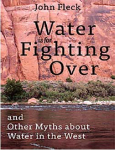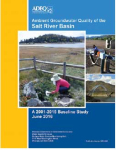Water is for Fighting Over and Other Myths about Water in the West

In Water is for Fighting Over and Other Myths about Water in the West, author John Fleck has written that rarity, an optimistic book about western water. Although he acknowledges the seriousness of our water resource problems, he emphasizes the history of cooperation, conservation, and innovation that helped solve past challenges. Telling a series of stories about individuals and communities and how they have made a difference through actions that reflect the spirit of collaborative problem solving, he provides a hopeful view of our water future.
Ambient Groundwater Quality of the Salt River Basin: A 2001-2015 Baseline Study
by Arizona Department of Environmental Quality, June 2016

The study, conducted by Arizona Department of Environmental Quality (ADEQ) Ambient Groundwater Monitoring Program, characterized the groundwater quality of the Salt River basin from 2001 to 2015. For the study, samples were collected from 45 wells and 30 springs. The Salt River basin is composed of four sub-basins: the Black River, White River, Salt River Canyon, and Salt River Lakes. The basin as a whole, with its backbone rugged mountains has minimal groundwater storage capabilities. And estimated 178,000 acre-feet of natural recharge occurs each year and aquifers store about 8.7 million acre-feet down to a depth of 1,200 feet. In terms of drinking water quality standards and salinity levels, the Salt River basin has some of the best groundwater in Arizona. The most pristine groundwater is in the uppermost Black River sub-basin and concentrations of measured constituents typically increase as the water moves to the lower sub-basins.
The report and a summary fact sheet can be found at https://www.azdeq.gov/node/882.
Investigation of the Feasibility of Developing Uniform Water Recycling Criteria for Direct Potable Reuse
by California State Water Resources Control Board
Draft Report released September 8, 2017
California undertook the task of investigating the feasibility of developing regulatory criteria for direct potable reuse of water. They convened two panels to provide advice: scientists and engineers with expertise in the various applicable subjects and stakeholders who would be affected by any regulatory actions. The 43-page Draft Report to the Legislature contains findings and recommendations that include the determination that the development of regulatory criteria is feasible if knowledge gaps are addressed. The panels investigated public health questions about health effects of contaminants, recycled water treatment technologies; the use of multiple barriers and sequential treatment processes; fail safe mechanisms; and monitoring needs. The primary knowledge gaps concern reliability of the treatment process when there is no environmental buffer. The report recommends that research to address knowledge gaps proceed simultaneously with efforts to develop criteria so that research results can be used to inform the development process.
The Draft Report can be accessed at http://www.waterboards.ca.gov/drinking_water/certlic/drinkingwater/documents/rw_dpr_criteria/draft_report_to_legislature_dpr_public_review.pdf

